18 The Science of Climate Change
arzimmrman; fhaider1; and zhuge
A Personal Statement
I grew up hearing the words “global warming” without a solid understanding of what was causing it and what could be done about it. My first clear memory of the issue was when the United States pulled out of the Paris Climate Accord for the first time. At thirteen, I did not fully understand the consequences of that policy decision, but I knew my parents were upset. I only gained a basic understanding of the issue through my biology and public health coursework at the University of Iowa. (ARZ)
If I could describe my feelings toward the current situation in one word, it would be “disheartened”. I still believe there is a solution, but progress toward it is glacially slow, and so, the chances of preventing irreversible climate change get smaller and smaller with each year. It is frustrating to see the people in power and those around me become resigned to an unsustainable future or, worse, choose to believe it doesn’t exist despite the wealth of evidence to the contrary. I am continually shocked by the need of corporations to put profits over the needs of the planet we live on and the politicians who prevent the system from changing for the better. I do what I can to reduce my carbon footprint, but I feel discouraged knowing that changes to my individual lifestyle won’t make a dent in the issue, especially when our society is centered around fossil fuels and other pollutants. (ARZ)
Pessimism is such a dominant attitude in my generation that many people feel there is no hope for future generations. It’s unlikely to become unbearable for many of us in my lifetime, but this problem will still be around for our descendants for many years to come. I have started hearing discussions among my peers about the ethics of starting a family when we know the future will be worse than the present. And even if we have not personally felt the effects of climate change yet, millions of people across the world who have been displaced due to climate-related disasters are living through them right now. This future is not far away. For many, it is already here. (ARZ)
I do think that there will be change in my lifetime. Climate change is one of the most important political issues for my generation and we will eventually be the majority voices in the conversation. That is the way of progress. However, it remains to be seen how long it will be until we reach that majority. If change does not come swiftly enough, it will have little benefit. The time for progress is running out. (ARZ)
The Science of Climate Change

A lot of terms get thrown around in discussions surrounding the issue of climate change, which can be confusing for the average person who may not understand how or why it is occurring, making it easy to fall into the trap of misinformation or outright denial. To fully understand and properly address the issue of global climate change, it is important to establish a scientific understanding of how we know it is occurring and what can be done to stop it. Otherwise, proposed solutions may be unrealistic or ineffective. In this section, I will break down the mechanisms behind global warming and climate change, followed by a discussion of certain interventions that can be implemented to prevent irreversible warming. (ARZ)
Global climate change is caused by the greenhouse effect, which, to clarify, is not necessarily a negative phenomenon. In fact, it is what makes the Earth habitable by creating warm conditions conducive to life. Its existence was first argued for in 1824 and supported by experimental observations in 1859. The phenomenon can be explained as follows: solar radiation passes through the Earth’s atmosphere and warms the Earth’s surface. The Earth, in turn, radiates energy back toward the atmosphere. However, some of this energy is absorbed by the gases in the atmosphere and used again to warm the Earth rather than being sent back into the vacuum of space. The atmosphere effectively acts as a blanket, trapping heat (Latake et al, 2015). (ARZ)
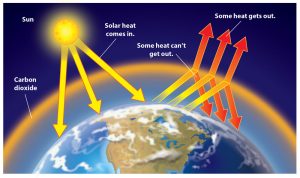
The primary gases that create the greenhouse effect are H2O (water), CO2 (carbon dioxide), CH4 (methane), N2O (nitrous oxide), O3 (ozone), and chlorofluorocarbons. In recent years, the danger of excess greenhouse gases in the atmosphere has been recognized. At higher concentrations of greenhouse gases, less solar radiation is able to escape into space and warming increases. A little warming sustains life. Too much will cause the Earth to become unsustainable. Human activities are responsible for this rise in gas concentrations–particularly CO2, CH4, and N2O. CO2 comprises approximately 72% of annual greenhouse gas emissions. It is released by the burning of fossil fuels and other human industrial processes. It is naturally removed from the atmosphere by plants as part of the carbon cycle. CH4 and NO2 are also emitted from the production of fossil fuels and the decomposition of agricultural waste and comprise 18% and 9%, respectively (Latake et al, 2015). (ARZ)
The primary gases that create the greenhouse effect are H2O (water), CO2 (carbon dioxide), CH4 (methane), N2O (nitrous oxide), O3 (ozone), and chlorofluorocarbons. In recent years, the danger of excess greenhouse gases in the atmosphere has been recognized. At higher concentrations of greenhouse gases, less solar radiation is able to escape into space and warming increases. A little warming sustains life. Too much will cause the Earth to become unsustainable. Human activities are responsible for this rise in greenhouse gas concentrations–particularly CO2, CH4, and N2O. CO2 comprises approximately 72% of annual greenhouse gas emissions. It is released by the burning of fossil fuels and other human industrial processes. It is naturally removed from the atmosphere by plants as part of the carbon cycle. CH4 and NO2 are also emitted from the production of fossil fuels and the decomposition of agricultural waste and comprise 18% and 9%, respectively (Latake et al, 2015). (ARZ)
But how do we know that the Earth is actually warming or that it is due to greenhouse gases? One of the most obvious pieces of evidence is the unprecedented rate of temperature increase we are currently experiencing. Up until 2008, temperature was increasing linearly at a rate of 0.18° C per decade. However, in the past fifteen years, that rate has doubled to 0.3° Celsius per decade with concerns that it could increase further (Hausfather, 2024). Data shows that 2024 was the hottest year since record keeping began in 1880, breaking the record set in 2023. The total increase since 1880 is approximately 1.47° C (NASA, 2025). In the 1970s, Yale economist William Nordhaus argued that if global warming were to exceed 2° C above the baseline, it would cause global conditions to be unlike any other experienced by mankind (Fendt, 2021). It might not seem like a large increase to most people, but as the global average, it is a very concerning shift in Earth’s climate system. (ARZ)
This increase in temperature can be directly correlated to an increase in CO2 concentrations. CO2 levels are naturally increased via volcanic activity and decomposition, but the current increase beginning in the industrial revolution is almost certainly due to fossil fuel emissions. CO2 levels have naturally fluctuated for millions of years, but current levels are the highest ever recorded and the rate of the increase unparalleled. Scientists have been able to compare current levels with prehistoric levels by examining the concentrations present in trapped air bubbles in glacial ice cores (Mulhern, 2024). (ARZ)
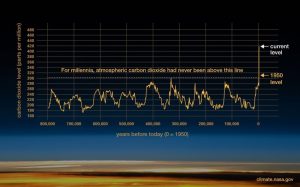
Even without quantitative data in temperature and CO2 concentrations, climate change is becoming increasingly evident in the presence of numerous environmental issues around the world. Natural disasters have become more intense in recent decades, notably leading to large-scale migrations of “climate refugees” who have been displaced from their homes (Ida, 2021). The uptick in wildfires on the West Coast of the United States is being caused by high temperatures drying out soil and vegetation, making it easier to ignite. Hurricanes and floods are being affected by an increased amount of evaporation and, subsequently, an increased amount of precipitation. Hurricanes are also affected by an increased amount of water being found in clouds, causing more powerful storms to develop (Crimmins, 2022). Additionally, due to a disproportionate amount of warming in the arctic, glaciers are shrinking and causing sea levels to rise around the world. The second largest contributor to rising sea levels is the melting of Greenland’s ice sheet alone. The largest contributor is the increased warming of the ocean, causing the water to expand due to the heat (Moran, 2023). Another issue impacting the ocean is its acidification due to rising CO2 concentrations. Water absorbs about a quarter of global CO2 emissions each year. As CO2 dissolves in salt water, it forms carbonic acid, lowering the pH of the ocean. Ocean acidification causes water to heat more easily, killing marine life and coral reefs. Since 1850, the ocean is increasing in acidity ten times faster than any period in the past fifty-five million years (Robinson, 2021). (ARZ)
Climate change also presents a significant threat to agriculture due to changes in temperature and precipitation. Plants are becoming less nutritious due to early ripening from the heat (Robinson, 2021). Droughts are also becoming more common worldwide, sparking worries about crop yields (Crimmins, 2022). CO2 concentrations are also affecting crop yields. Wheat and rice are particularly sensitive to CO2, which is worrying because these two crops are the main source of protein for approximately 70% of the world’s population. In the next few decades, it is likely that global protein deficiency will increase, largely due to this fact (Robinson, 2021). (ARZ)
Another notable way in which climate change poses a significant threat to human health is the increased range of insects that serve as vectors for infectious diseases. Warming temperatures affect the behavior and life histories of both pathogens and vectors, increasing the risk of spillover and disease spread to previously unaffected areas. Malaria, dengue, Lyme disease, and West Nile virus are four diseases that are especially predicted to rise in prevalence over the next 80 years (Thomson et al, 2022). (ARZ)
Ecologists have also sounded the alarm about climate change’s danger to species conservation. The Earth has gone through at least five mass extinctions caused by natural means. However, we are approaching a sixth mass extinction that is entirely manmade. Not only is this a moral failing on humanity’s part, but it further compounds the dangers climate change presents to us. The rapid rate of species extinction is causing a chain reaction, eroding key ecosystems worldwide along with the services they render to us, including pest control, pollination, photosynthesis, water purification, raw materials, and medicine (Robinson, 2021). (ARZ)

Despite a wealth of evidence pointing to its existence, the concept of climate change has been much denied in the past few decades. Much of this denial has even been fueled by the fossil fuel industry and other corporations (Yoder, 2022). Many argue that changes in Earth’s climate are nothing new, as it has fluctuated many times during its four-billion-year history. However, we know that our current climate change is highly unusual, and it cannot be explained by natural cycles of variation. One such phenomenon is the Milankovitch Cycle, which consists of natural variations in Earth’s orbit around the sun. Milankovitch cycles cause ice ages and the warmer periods in between them (Kaufman et al. 2009). This phenomenon has been well established, as researchers have been able to collect detailed records of proxy data estimating temperatures for the past few thousand years. For example, observing the width of rings in the trunks of very old trees can provide information about warm-season temperatures at the time of growth. Additionally, biological indicators in ancient lake sediments can provide information about lake activity, which is primarily controlled by temperature (Kaufman et al. 2009). Skeptics will often cite this as proof that climate change is natural, however, the evidence indicates that Milankovitch cycles cannot explain the sudden rise in temperature. In fact, the proxy temperature data indicates that the Earth was in a consistent cooling period until the industrial revolution and the rise of fossil fuels in the mid-1800s (Kaufman et al. 2009). (ARZ)
Another factor in variations in Earth’s climate is solar flare activity. These are intense bursts of radiation on the surface of the sun that can travel as much as ninety thousand miles from the surface and can last for months (Crockett, 2021). They have been linked to rises in the Earth’s surface temperature in the past, but solar flare activity has actually gone down in recent years, with no net increase since the 1950s (NASA, 2019). Since natural cycles of climate variation cannot explain the current rise in Earth’s surface temperature, the IPCC states that it is “indisputable” that human activities are responsible for climate change and the extreme climate events that accompany it (Lee, 2022). (ARZ)
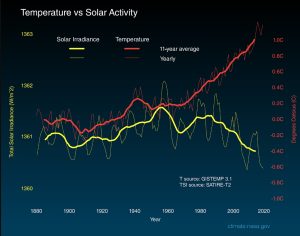
There is no question anymore that climate change is occurring, but the question of how to mitigate its effects has been a puzzling one. Since CO2 comprises the vast majority of emissions, many have suggested that humans quit using fossil fuels and switch entirely to renewable energy like solar power. This is a tempting solution at first glance, but it will be very difficult for the society we live in. The modern economy runs almost entirely on fossil fuels, and they pervade every aspect of our lives. (ARZ)
When oil is extracted from deep within the earth, it is refined by manufacturers for industrial and commercial use. This process produces a wide range of hydrocarbon byproducts used to make materials like plastic, rubber, wax, fabric. Everything from cars to medicine to even solar panels is made from byproducts produced during the refining process (Admin, 2020). This heavy reliance on fossil fuels is what lies at the heart of the issue. There are certainly ways to make alternatives to these materials, but reducing our emissions will require a complete transformation of the way our society operates. Even then, fossil fuels will likely still be needed for certain sectors of the global economy. Long-distance transportation, especially aviation and maritime shipping, will still require large amounts of fossil fuel energy that alternatives cannot provide. There are also certain industrial processes–such as the making of glass, steel, and cement–that require high heat that would be incredibly difficult to achieve without burning fossil fuels (Gross, 2020). (ARZ)
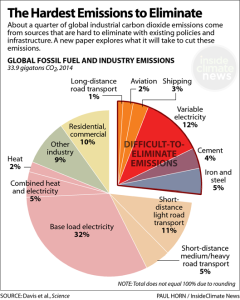
Our reliance on fossil fuels may make the situation seem hopeless, especially since people are unlikely to push for economic sacrifices in exchange for benefits that might not be immediately apparent, although far more than the economy will suffer if climate change continues to go unchecked. However, there may be a feasible solution that allows us to protect our planet in a way that assuages economic concerns. One major solution offered to combat climate change is to push for governments and companies to reach net zero CO2 emissions. This means that total emissions must be reduced to the point where they are equal to total carbon removal. Net zero emissions would prevent excess CO2 from being added to the atmosphere (Wood, 2021), which will likely help mitigate the future effects of climate change. This will not cause warming to cease overnight, as the high CO2 concentrations in the atmosphere will continue to contribute to the greenhouse effect. However, talking about net zero and how to achieve it may be essential in keeping the earth tolerable for the global ecosystem. (ARZ)
The first step to achieving net zero is reducing carbon emissions where they can be reduced. There is a lot that people can do on an individual basis to reduce their carbon footprint, such as cutting back on their consumption of certain goods, switching to hybrid or electric vehicles, reducing their screen time, and even going vegetarian (Biello, 2007). However, individual actions can only go so far when the majority of our goods are made with fossil fuels and government policy incentivizes corporations to continue polluting the atmosphere. As stated before, reducing carbon emissions will require a transformation of the way our society operates. (ARZ)
Fossil fuels are a multi-trillion-dollar industry (Gross, 2020) whose high profits have come at the expense of the planet. One promising suggestion is a carbon tax implemented by governments. This would involve putting a direct financial penalty on every ton of CO2 released into the atmosphere, incentivizing both consumers and corporations to choose greener alternatives to fossil fuels and their products. Sweden was the first country to do this, and it represents a success story on this front, having reduced their greenhouse gas emissions by 27 percent since their tax’s implementation in 1991 (Jonsson et al, 2020). Many other countries have followed suit (Robinson, 2021). Governments should also reduce subsidies and other forms of financial support to fossil fuel companies and use the money to support the clean energy transition (Wood, 2021). This will require funding for research into clean energy alternatives to common uses of fossil fuels due to the amount of emissions that will be difficult to reduce. Part of this support must also include aid to clean energy projects in low-income countries, as climate change solutions need to include the entire world if we can hope to meet certain climate action goals. (ARZ)
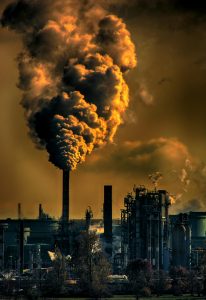
Major infrastructure upgrades can do a lot to lower greenhouse gas emissions. Buildings alone contribute to about a third of emissions worldwide, largely due to the use of fossil fuels in heating (Biello, 2007). New infrastructure upgrades could do a lot to lower their role in climate change. Additionally, bad roads can lower the fuel economy of even fuel-efficient vehicles. One concern that could arise in this solution is the amount of greenhouse gas emissions that could be released in the project. Cement would be required to fix the poor roads, and cement is one of the sectors in which emissions will be difficult to eliminate (Biello, 2007). The costs and benefits should be weighed to determine how best to do this. (ARZ)
For industries where the continued use of fossil fuels is essential, one possibility is the increased use of carbon capture. This relatively inexpensive process allows the burning of fossil fuels and the creation of CO2 in industrial processes, but instead of being released into the atmosphere, the CO2 is “captured” and injected deep into the earth or recycled in other industrial processes, such as enhanced oil recovery (Gross, 2020). This allows humans to enjoy the benefits of fossil fuel use without contributing to the greenhouse effect. (ARZ)
Another key solution to the climate change issue will be the reduction of waste and wasteful products, even those largely unrelated to fossil fuel usage. For example, food waste is a major greenhouse gas emitter. In fact, it’s the third-largest emitter of CO2, just behind the United States and China. Roughly a third of all food grown for human consumption is wasted, left to decompose and release millions of tons of carbon (Robinson, 2021). Much of this food is thrown out by supermarkets purely due to aesthetic reasons that have little to do with the quality of the item. Supporting local farmers can be a good way to prevent this from happening. Another way to reduce food waste is to educate consumers on the difference between “use by” dates and “best before” dates. The former is perishable at the date printed on the packaging, while the latter is not at its highest quality, but is still edible and should not be thrown out right away (Robinson, 2021). (ARZ)
Another form of waste that must be reduced is the use of single-use plastics and other hydrocarbon byproducts. While there are certain sectors of the economy in which fossil fuels will remain an essential resource, many products made with hydrocarbon byproducts can also be made with alternatives to single-use plastics. While much maligned by climate change deniers, paper straws and other products made from biodegradable materials are a good starting point for this transition. More funding should be put toward investigating alternatives to hydrocarbon byproducts in both consumer and industrial products and incentivizing their use. (ARZ)
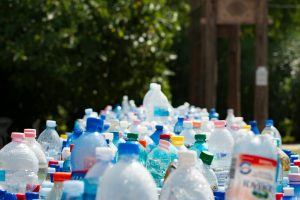
The second step to achieving net zero is investing in carbon removal, which is direct removal of carbon from the atmosphere. This might be a bit challenging, as many carbon removal technologies are still in their infancy. The most obvious and cost-effective strategy is tree restoration. CO2 is used by trees and other plants to make other carbon compounds necessary for their nutrition and structure. Restoring tree cover in forest ecosystems and urban areas as well as incorporating it into animal and crop agriculture systems can have a huge impact on offsetting carbon emissions. It’s estimated that the US has the potential to plant approximately sixty billion trees without decreasing food production, which would remove 500 million metric tons of CO2 from the atmosphere annually (Rudee, 2020). (ARZ)
One intriguing method of carbon removal is biomass carbon removal and storage, or BiCRS. This method harnesses the natural carbon sequestration abilities of plants and algae to remove CO2 from the atmosphere and store it long-term. The interesting thing about this method is that the plant and algal material can still store carbon after death and decomposition in this process (Mulligan et al, 2023). BiCRS encompasses a range of processes, such as converting biomass to a soil additive or a liquid that is injected underground. Not all these processes provide a net carbon benefit, so different interventions should be individually evaluated. Experts also advise that waste biomass should be used in these processes instead of crops grown specifically for the use of BiCRS due to concern for food insecurity and ecosystem displacement (Mulligan et al, 2023). (ARZ)
Another method put forward for carbon removal is direct air capture. Unlike carbon capture, which only captures CO2 at the point of emissions, direct air capture functions at any location and captures CO2 directly from the atmosphere. The captured CO2 can be used for industrial applications or stored underground. Unfortunately, this process has very high energy demands since CO2 concentration is much lower in the atmosphere than it is in industrial emissions. This makes it one of the most expensive interventions for carbon removal (Budinis, 2024). The costs of direct air capture are expected to be less of a barrier in the future, however, as technology improves, and interest grows (Mulligan et al, 2023). (ARZ)
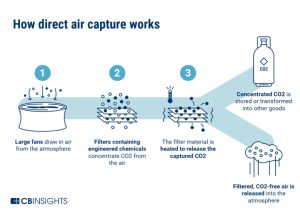
One final method for carbon removal that is attracting interest is carbon mineralization. This process involves the acceleration of reactions between CO2 and certain minerals, allowing CO2 to be stored in solid form. There are multiple approaches to this, including injecting dissolved or condensed CO2 into subsurface rock or reacting CO2 with crushed alkaline rock, the latter of which often requires high heat and pressure. This process can be used to make more efficient cement as well as reduce health hazards associated with mining waste. If this process was to become more widespread, caution would need to be exercised to prevent the release of heavy metals from the target minerals. Ultimately, more research is needed on the chemistry of certain materials with respect to this process and the possible environmental impacts (Riedl et al, 2023). (ARZ)
Although CO2 represents the majority of greenhouse gas emissions and is the major focus of this essay, it is important to include a short discussion on how to limit emissions of methane and nitrous oxide. These are especially powerful greenhouse gases and reducing their emissions may be key to preventing irreversible climate change. This may actually be easier than reducing CO2 emissions because the burning of fossil fuels is not the primary contributor. Like CO2 emissions, methane emissions can be limited by cutting back on fossil fuel production and food waste. The biggest emissions of methane, however, come from the rearing of livestock for human consumption, particularly from the belching of cows. Reducing consumption of meat and dairy products and eating more vegetables may lead to a significant decrease in methane emissions (Hirsh, 2021). Nitrous oxide emissions can also be limited in this way since livestock manure is a major contributor. Reducing these emissions on a per capita level will involve changes in livestock diets and better waste management practices. Nitrous oxide emissions can also be reduced via the use of more nitrogen-efficient fertilizers and more conservative application of nitrogen fertilizers (Hanqin et al, 2024). (ARZ)
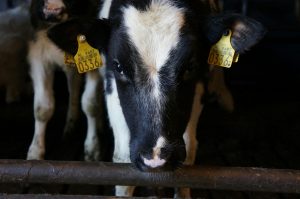
This section is an introduction to the causes and effects of climate change and interventions to address emissions. There is much more information out there, but the hope in writing this section is to provide readers with the foundational knowledge to participate in discussions about this issue and perhaps educate others who are willing to listen. This is a very real problem that our planet is facing, and it is one that we have created ourselves. Effective solutions will require investment and economic sacrifice, but those solutions cannot be implemented without awareness by the public. Only then can we put pressure on powerful actors like governments and corporations. In the next section of this chapter, my co-author Liwang Zhuge will discuss national-level impacts on environmental health in the United States and federal policy implemented to address those effects. (ARZ)
References:
Admin, S. (2020, May 15). 75 uses of fossil fuels in daily life. All Uses of. https://allusesof.com/energy/75-uses-of-fossil-fuels-in-daily-life/
Biello, D. (2007, November 26). 10 solutions for climate change. Scientific American. https://www.scientificamerican.com/article/10-solutions-for-climate-change/
Budinis, S. (2024, April 25). Direct air capture – energy system. IEA. https://www.iea.org/energy-system/carbon-capture-utilisation-and-storage/direct-air-capture
Crimmins, M. (2022, December 21). How climate change impacts each type of natural disaster. PBS. https://www.pbs.org/wnet/peril-and-promise/2022/09/how-climate-change-impacts-each-type-of-natural-disaster/
Crockett, C. (2023, May 18). Understanding just how big solar flares can get. Astronomy Magazine. https://www.astronomy.com/science/understanding-just-how-big-solar-flares-can-get/
Fendt, L. (2021, June 22). Why did the IPCC choose 2° C as the goal for limiting global warming?. MIT Climate Portal. (n.d.-b). https://climate.mit.edu/ask-mit/why-did-ipcc-choose-2deg-c-goal-limiting-global-warming
Gross, S. (2023, October 26). Why are fossil fuels so hard to quit?. Brookings. https://www.brookings.edu/articles/why-are-fossil-fuels-so-hard-to-quit/
Hanqin, T., Davidson, E., Canadell, P., Thompson, R. L. (2025, February 17). Food has a climate problem: Nitrous oxide emissions are accelerating with growing demand for fertilizer and meat – but there are solutions. The Conversation. https://theconversation.com/food-has-a-climate-problem-nitrous-oxide-emissions-are-accelerating-with-growing-demand-for-fertilizer-and-meat-but-there-are-solutions-231372
Hausfather, Z. (2024, April 4). Factcheck: Why the recent “acceleration” in global warming is what scientists expect. Carbon Brief. https://www.carbonbrief.org/factcheck-why-the-recent-acceleration-in-global-warming-is-what-scientists-expect/
Hirsh, S. (2021, May 7). Slashing methane emissions by 45 percent is crucial to avoid climate catastrophe – and easy, says UN Report. Green Matters. https://www.greenmatters.com/p/how-reduce-methane-emissions
Ida, T. (2021, June 18). Climate refugees – the world’s forgotten victims. World Economic Forum. https://www.weforum.org/stories/2021/06/climate-refugees-the-world-s-forgotten-victims/
Jonsson, S., Ydstedt A., Asen E. (2023, November 22). Looking back on 30 years of carbon taxes in Sweden. Tax Foundation. https://taxfoundation.org/research/all/eu/sweden-carbon-tax-revenue-greenhouse-gas-emissions/
Kaufman et al., Recent Warming Reverses Long-Term Arctic Cooling. Science 325,1236-1239(2009).DOI:10.1126/science.1173983
Latake, P.T., Pawar, P. and Ranveer, A.C., 2015. The greenhouse effect and its impacts on environment. Int. J. Innov. Res. Creat. Technol, 1(3), pp.333-337.
Lee, H. (2022, June 9). Keynote address by the IPCC chair Hoesung Lee at the opening of the first technical dialogue of the global stocktake. IPCC. https://www.ipcc.ch/2022/06/10/keynote-address-hoesung-lee-technical-dialogue-global-stocktake/
Moran, B. (2023, December 12). Arctic “report card” points to rapid and dramatic impacts of climate change. NPR. https://www.npr.org/2023/12/12/1218764341/noaa-arctic-report-card-climate-change-impacts
Mulhern, O. (2024, March 4). A graphical history of atmospheric CO2 levels over time. Earth.Org. https://earth.org/data_visualization/a-brief-history-of-co2/
Mulligan, J., Ellison, G., Levin, K., Lebling, K., Rudee, A., & Leslie-Bole, H. (2023, March 17). 6 ways to remove carbon pollution from the atmosphere. World Resources Institute. https://www.wri.org/insights/6-ways-remove-carbon-pollution-sky
NASA. (2024, October 23). Graphic: Temperature vs solar activity – NASA science. NASA. https://science.nasa.gov/resource/graphic-temperature-vs-solar-activity/
NASA. (2025, January 10). Temperatures rising: NASA confirms 2024 Warmest Year on record. NASA. https://www.nasa.gov/news-release/temperatures-rising-nasa-confirms-2024-warmest-year-on-record/
Riedl, D., Byrum, Z., Li, S., Pilorgé, H., Psarras, P., & Lebling, K. (2023, June 22). 5 things to know about carbon mineralization. World Resources Institute. https://www.wri.org/insights/carbon-mineralization-carbon-removal
Robinson, D. (2024, March 5). Climate change: Problems and solutions. Earth.Org. https://earth.org/climate-change-problems-and-solutions/
Rudee, A. (2020, February 12). How and where to plant 60 billion trees in the US. World Resources Institute. https://www.wri.org/insights/how-and-where-plant-60-billion-trees-us
Thomson, M., Stanberry, L., 2022. Climate Change and Vectorborne Diseases. N Engl J Med 2022;387:1969-1978
Wood, J. (2021, November 9). What does net zero emissions mean and how can we get there?. World Economic Forum. https://www.weforum.org/stories/2021/11/net-zero-emissions-cop26-climate-change/
Yoder, K. (2022, April 15). They derailed climate action for a decade. and bragged about it. Grist. https://grist.org/accountability/how-the-global-climate-coalition-derailed-climate-action/
